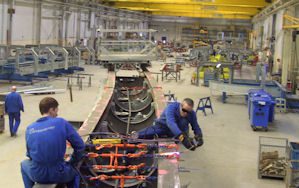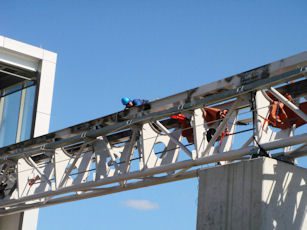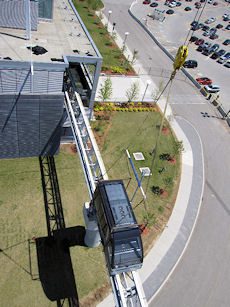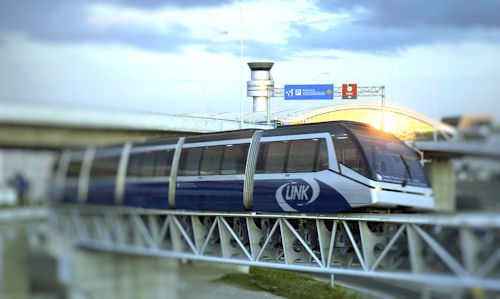It was a combination third anniversary and grand re-opening when trains began rolling at Toronto Pearson International Airport last July. LINK, the airport’s automated people mover that debuted in July 2006, had been closed for three months while crews performed C$4 million of repairs on trains and guideways that originally cost C$56 million.

Passenger safety did not prompt the shutdown or repairs, emphasizes Iouri Moutine, manager of people moving devices for the Greater Toronto Airport Authority. The LINK trains met all operational and safety standards, Moutine stresses, but a “latent issue” that emerged after the system began operating presented potential long-term complications.
 “We detected some lateral vibration during the movement of the train,” he explains. “This vibration was causing deterioration of certain mechanical components of the train. Doppelmayr (the company that engineered and installed the system) came up with a solution and rectified the problem.”
“We detected some lateral vibration during the movement of the train,” he explains. “This vibration was causing deterioration of certain mechanical components of the train. Doppelmayr (the company that engineered and installed the system) came up with a solution and rectified the problem.”
The vehicle bogies, which provide suspension beneath individual cars, were components most affected, and mechanics were replacing them more frequently than expected. The ride for passengers was also not as smooth as it should have been.
Doppelmayr Cable Car (DCC) determined that its contract to operate and maintain the system wouldn’t be profitable until it resolved the vibration issue. After securing permission from the airport for a three-month suspension of service, DCC performed and warranted C$4million of repairs. The airport, in turn, covered the cost of temporary bus service to areas previously served by the LINK trains – between terminals one and three and to/from remote parking.
A Complex Challenge
One of the key advantages to cable-propelled systems such as LINK is their relatively lightweight guideway structures – a particularly compelling factor at Toronto Pearson, where the system was constrained to a route that was vertically and laterally complex.
 The complexity of the route, however, created design and fabrication challenges. Despite directional changes, guideway surfaces had to be smooth and free of bumps and deviations. Alignment tolerances were limited to two millimeters per two-meter length of guideway.
The complexity of the route, however, created design and fabrication challenges. Despite directional changes, guideway surfaces had to be smooth and free of bumps and deviations. Alignment tolerances were limited to two millimeters per two-meter length of guideway.
“The entire guideway alignment is very tricky,” explains DCC senior project manager Markus Haemmerle. “The fabrication has to be very precise. While the initial fabrication work (for LINK guideways) met requirements, we subsequently learned that the tolerances were borderline.”
 DCC tapped in-house personnel and outside consultants to devise a strategy to tighten the tolerances and correct the associated vibrations. Straightening and smoothing guideways with heat emerged as the optimal answer. A 50-meter mockup helped team members determine how to apply heat in the proper amount and duration to make necessary adjustments to guideway beams.
DCC tapped in-house personnel and outside consultants to devise a strategy to tighten the tolerances and correct the associated vibrations. Straightening and smoothing guideways with heat emerged as the optimal answer. A 50-meter mockup helped team members determine how to apply heat in the proper amount and duration to make necessary adjustments to guideway beams.
“The solution was very unique,” Haemmerle says. “While heat is used to fabricate the beams, this is generally done in the shop where the structure is on the floor and not fastened together. The corrections are very difficult to obtain when everything is torqued and tensioned. If too much heat is applied, the metal can bend in the wrong direction.”
  |
In addition to modifying the guideways, DCC installed new bogie systems in each car. Both fixes required crews to work 24/7 for the full three months available to them. Coordinating with airport safety inspectors and local authorities required careful planning – especially when work required the closing of an airport access road.
“It was a very aggressive project,” recalls Moutine, noting that the airport authority is “very pleased” with the results. “We had to essentially rebuild the system. Doppelmayr is a very professional company and they stand behind their product 100%. They followed the schedule and plans exactly as we had agreed upon and delivered the system back on line on the scheduled date.”
|
Facts & Figures Project: Repair of Automated People Mover (APM) Location: Toronto Pearson International Airport Approximate Cost: C$4 million ($5.75 million U.S.) APM Manufacturer: Doppelmayr Cable Car & Co. Flame Straightening & Mockup Production: Stakotra Manufacturing Engineering Consultation and Joint Repairs: ANCAM Solutions Co. Ltd. Paint Repair: Harrison Muir Inc. Safety Consultant: Technical Standards & Safety Authority Key Benefits: Increase life of mechanical components; improve ride comfort |
Back to Normal
With LINK resuming its regular 24/7 schedule, Toronto Pearson is once again relieving groundside traffic congestion and reducing pollution from buses – the two primary benefits that originally inspired the project.
The system includes two six-car trains that run independently on two elevated tracks spanning .9 mile. Each car holds 36 people, and the system is capable of moving 2,150 passengers/hour/direction. Round trip travel time is about eight minutes.
“Essentially,” Moutine notes, “we’re capable of transporting 50,000 people a day. During our peak usage times, when work shifts change or during peak travel times, we’re able to accommodate our passengers with a higher level of service so they have minimal waiting time at the stations.”
The original C$140 million LINK project is a small portion of the airport authority’s 20-year, C$4.4 billion program for overall terminal and landside/airside expansion.



